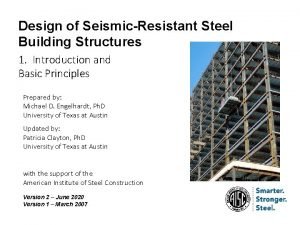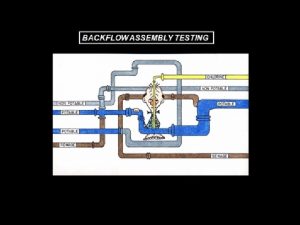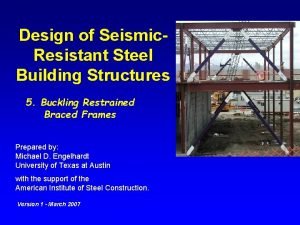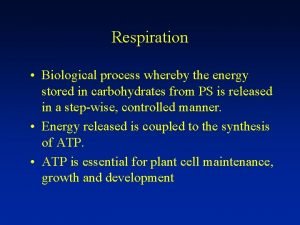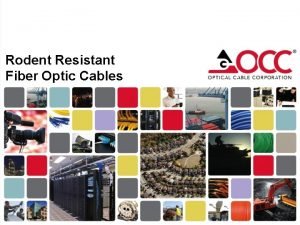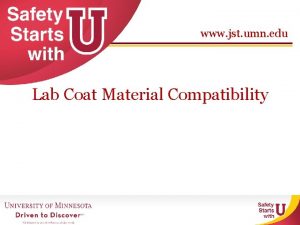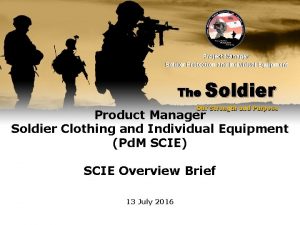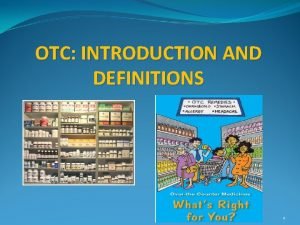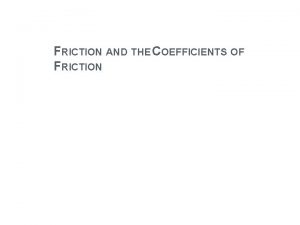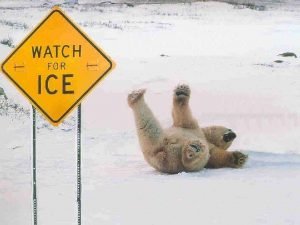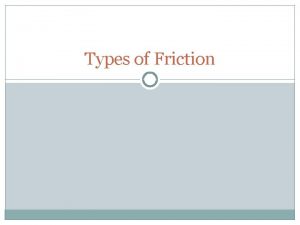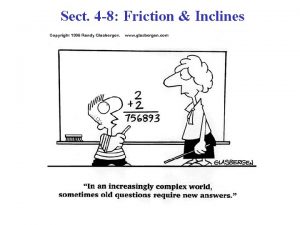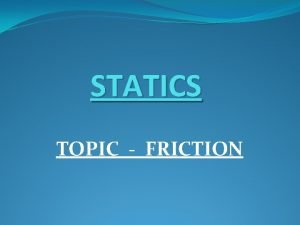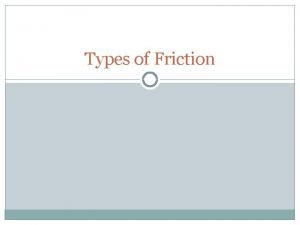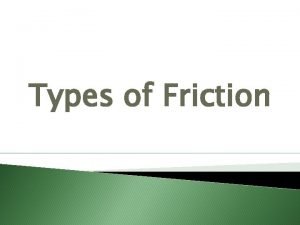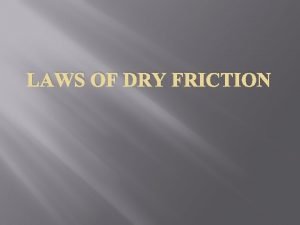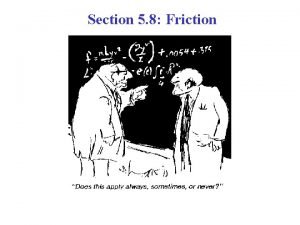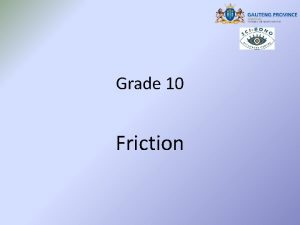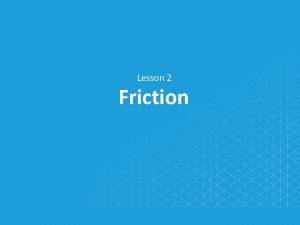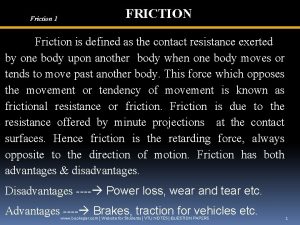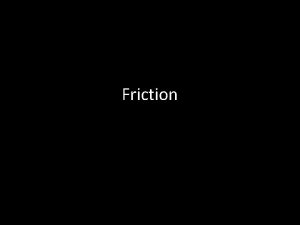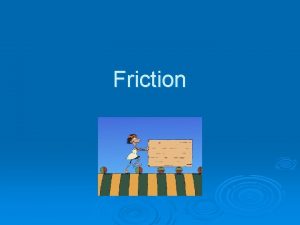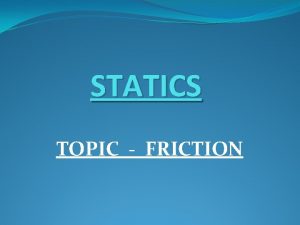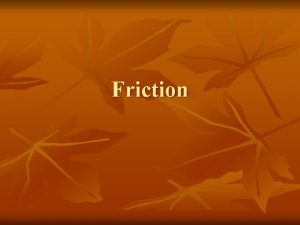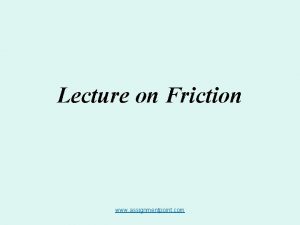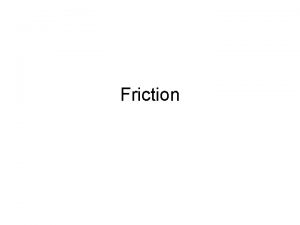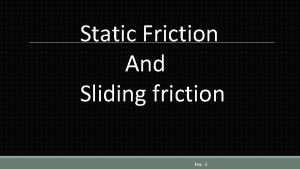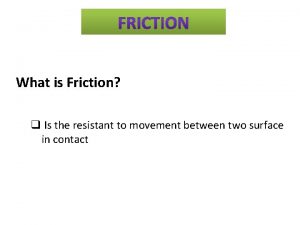What is Friction q Is the resistant to

























- Slides: 25

What is Friction? q Is the resistant to movement between two surface in contact

• Friction is the force that opposes motion between any surfaces that are in contact. There are four types of friction: • static, sliding, rolling, and fluid friction. • Static, sliding, and rolling friction occur between solid surfaces. • Fluid friction occurs in liquids and gases.

Static Friction • Static friction acts on objects when they are resting on a surface. • For example, if you are hiking in the woods, there is static friction between your shoes and the trail each time you put down your foot (see Figure ). • Without this static friction, your feet would slip out from under you, making it difficult to walk. • In fact, that's exactly what happens if you try to walk on ice. That's because ice is very slippery and offers very little friction.

Sliding Friction • Sliding friction is friction that acts on objects when they are sliding over a surface. • Sliding friction is weaker than static friction. • That's why it's easier to slide a piece of furniture over the floor after you start it moving than it is to get it moving in the first place. Sliding friction can be useful. • For example, you use sliding friction when you write with a pencil. The pencil “lead” slides easily over the paper, but there's just enough friction between the pencil and paper to leave a mark. • Q: How does sliding friction help you ride a bike? • A: There is sliding friction between the brake pads and bike rims each time you use your bike's brakes. This friction slows the rolling wheels so you can stop.

Rolling Friction • Rolling friction is friction that acts on objects when they are rolling over a surface. • Rolling friction is much weaker than sliding friction or static friction. • This explains why most forms of ground transportation use wheels, including bicycles, cars, 4 -wheelers, roller skates, scooters, and skateboards. • Ball bearings are another use of rolling friction. You can see what they look like in the Figure. They let parts of a wheel or other machine roll rather than slide over on another. • The ball bearings in this wheel reduce friction between the inner and outer cylinders when they turn.

Fluid Friction • Fluid friction is friction that acts on objects that are moving through a fluid. • A fluid is a substance that can flow and take the shape of its container. Fluids include liquids and gases. • If you've ever tried to push your open hand through the water in a tub or pool, then you've experienced fluid friction. You can feel the resistance of the water against your hand. • Look at the skydiver in the Figure, He's falling toward Earth with a parachute. Resistance of the air against the parachute slows his descent. • The faster or larger a moving object is, the greater is the fluid friction resisting its motion. That's why there is greater air resistance against the parachute than the skydiver's body.

The amount of friction resistance depends On : q The roughness of the two surface in contact q The size of the force which kept the two surface in contact Advantages of Friction in the workshop: q Holding work in a vice q Holding work in the lathe chuck q Clamping work q Brakes

Advantages of Friction: • Friction is responsible for many types of motion • It helps us walk on the ground • Brakes in a car make use of friction to stop the car • Asteroids are burnt in the atmosphere before reaching Earth due to friction. • It helps in the generation of heat when we rub our hands.

Disadvantages of Friction: • Friction produces unnecessary heat leading to the wastage of energy. • The force of friction acts in the opposite direction of motion, so friction slows down the motion of moving objects. • Forest fires are caused due to the friction between tree branches. • A lot of money goes into preventing friction and the usual wear and tear caused by it by using techniques like greasing and oiling.

Disadvantage of Friction q Causing Extra effort q Wear q Heat Generation Selection of Materials to Reduce friction: q Materials should be made of different materials Example: q A steel shaft rotates in a white metal or bronze bearing

Factors That Affect Friction A number of factors affect the frictional conditions at the interface between these two surfaces in relative motion. These factors are: • Surface Finish — The number, roughness and even the directional contact points of the asperities on the surfaces can dramatically affect the frictional coefficient. • Temperature — Both ambient and operational temperature can affect friction. For example, temperature is a critical element in whether an anti-wear or extreme pressure additive will be effective in certain applications. • Operational Load — Friction varies directly with load. A load exceeding the designed capacity will dramatically increase the frictional coefficient.

• Relative Speed — Increasing the speed beyond that which is safely specified will dramatically increase friction. • Nature of the Relative Motion between the Surfaces — Sliding motion versus rolling motion can affect the coefficient of friction. • Lubricant Characteristics — These characteristics are the base oil, the viscosity of the base oil and the additives combined with the base oil for the particular formulation. The challenge is to reduce the coefficient of friction as much as possible by either eliminating the factors that may have an adverse effect on the surface in relative motion or at the very least controlling those factors.

Reducing Friction There are several ways to reduce friction: • The use of bearing surfaces that are themselves sacrificial, such as low shear materials, of which lead/copper journal bearings are an example. • Replace sliding friction with rolling element friction, such as with the use of rolling element bearing. • Improve overall lubrication either by changing viscosity, using differing or improved additives or through the use of different lubricants themselves, i. e. , synthetics, solids, etc.

Lubrication (Reduced Friction) q. Main purpose of lubrication is to reduce wear and tear q. Oiliness of surface q. Oils and Grease are mostly used as lubricants q. Moving parts of machines are lubricated in order to maintain its function. (ball bearings, gear box, rollers and etc. ) q Manufacturer’s recommendation should always be followed when using lubricating oils Viscosity q. Resistance to motion caused by the particles of oil sliding over one another

SIMPLE MACHINES

Simple Machines • Simple machines are devices with few or no moving parts that make work easier. • Examples of simple machines are the wedge, wheel and axle, lever, inclined plane, screw, and pulley • In the context of the construction of a pyramid, gaining high-level insights into tools that have been used since ancient times and are still in use today.

A pulley is an example of a simple machine

Wedge • Pushes materials apart, cuts things • Examples: axe, doorstop, chisel, nail, saw, jackhammer, bulldozer, snow plow, horse plow, zipper, scissors, airplane wing, knife, fork, bow of a boat or ship

Complex Machines ● ● Combining two or more simple machines to work together Examples: ○ Car jack combines wedge and screw ○ Crane or tow truck combines lever and pulley ○ Wheelbarrow combines wheel and axle with a lever

Summary Wedge Pushes material apart, cuts Wheel and Axle Makes it easy to move things by rolling them, and reducing friction Lever Helps lift heavy weights using longer distances Inclined Plane Makes it easier to move objects upward; a longer path, but easier lifting Screw Turns rotation into lengthwise movement Pulley Makes lifting heavy weights easier by redirecting force

Mechanical Advantage and Velocity Ratio: q Effort (FE) – Forced exerted on the machine. q Load (FL) – Forced on the output side of the machine Mechanical advantage: q Relationship between the load and the effort which gives an indication of the advantage that can be obtained by using the machine Mechanical Advantage = Load / Effort OR MA = FL / FE

Velocity Ratio q Ratio of the distance moved through by the effort on the input side (SE) to the distance moved through by the load on the output side (SL) Velocity Ratio = distance moved by Effort / distance moved by load OR VR = SE / SL

Work and Efficiency: q (Input side) Work done by the Effort: Work done by Effort (WE) = FE X SE q (Output side) Work done in moving the Load: q Efficiency : Eff. = WL /WE WL = FL X SL

Example : A simple machine is represented diagrammatically below. The load is 450 N and the effort is 50 N. The distance moved by the load and by the effort are 100 mm and 1200 mm respectively. Calculate the mechanical advantage, velocity ratio, input work, output work and the efficiency. FE = 50 N SE = 1200 mm MACHINE SL = 100 mm

Solution: a. Mechanical advantage: q MA = FL / FE = 450 N /50 N =9 b. Velocity Ratio: q VR = SE / SL = 1200 mm /100 mm = 12 c. Input work: q WE = 50 N X 1. 2 m = 60 J d. Output work: q WL = 450 N X 0. 1 m = 45 J e. Efficiency: q Eff. = WL / WE = 45 /60 = 0. 75 = 75% Efficiency is expressed as %. Actually machines efficiency is always less than 100%
 Jill is climbing
Jill is climbing Collision resistant hash function
Collision resistant hash function Arc resistant switchgear
Arc resistant switchgear Examples of tension
Examples of tension Spill resistant vacuum breaker
Spill resistant vacuum breaker Iatrogenic withdrawal syndrome
Iatrogenic withdrawal syndrome Insect-resistant packaging solutions
Insect-resistant packaging solutions Cryptographic
Cryptographic Design of seismic-resistant steel building structures
Design of seismic-resistant steel building structures Cyanide-resistant respiration slideshare
Cyanide-resistant respiration slideshare Tuned mass damper
Tuned mass damper Fire resistant cable thai yazaki
Fire resistant cable thai yazaki Rodent resistant fiber optic cable
Rodent resistant fiber optic cable Glycopeptide
Glycopeptide Resistant materials tools
Resistant materials tools Puncture resistant container
Puncture resistant container Flame resistant lab coat amazon
Flame resistant lab coat amazon Fire resistant environmental ensemble
Fire resistant environmental ensemble Flavours into overthecounter otc pharmaceuticals market
Flavours into overthecounter otc pharmaceuticals market Thẻ vin
Thẻ vin Giọng cùng tên là
Giọng cùng tên là Thơ thất ngôn tứ tuyệt đường luật
Thơ thất ngôn tứ tuyệt đường luật Chúa sống lại
Chúa sống lại Khi nào hổ con có thể sống độc lập
Khi nào hổ con có thể sống độc lập Diễn thế sinh thái là
Diễn thế sinh thái là Vẽ hình chiếu vuông góc của vật thể sau
Vẽ hình chiếu vuông góc của vật thể sau



